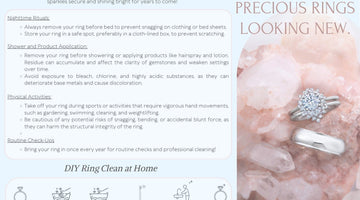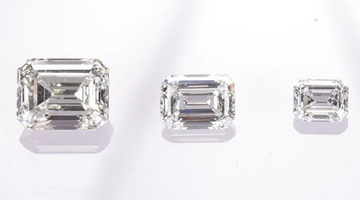One of the biggest questions we get from our clients is regarding the difference in Platinum and White Gold.
At the end of the day, it really is a personal preference and depends on many factors, such as budget, allergies to certain alloys, comfortability based on density, maintenance preferences, and overall ring design or style of jewelry.
First, let us start of with a basic understanding of the two metals as defined in Wikipedia:
One of the most widely misunderstood aspect of these two metals is the concept of hardness versus malleability. In short, white gold is harder than platinum and easier to work with because is is more malleable (or bendable). Although technically in its purest form, gold is a softer metal than platinum, keep in mind that white gold is mixed with white metal alloys which makes the white gold a harder metal after being mixed, so it is also a safe metal to hold precious gems. Comparatively, when used in jewelry, Platinum is technically a softer metal, which means it scratches, dents and dulls quickly, but it is less malleable which makes it stronger for holding gems and stones. Platinum is a very difficult metal to bend and and very few bench jewelers have the right tools and experience to properly work with it. Alternatively, white gold being more malleable is easier to work with therefore most jewelers would recommend white gold over platinum.
Sounds counter-intuitive right? What this means is that gold being that it is harder than platinum, can snap and break easier but scratch and dent less, and platinum while it is is softer can easily be scratched or dented but is less malleable meaning the prongs are technically safer. It would take a lot of mishandling to break a prong in either white gold or platinum, but platinum in theory is a safer or stronger metal than white gold.
Investment & Price
Both white gold and platinum historically have been great investments over time, however gold is a little easier to sell or liquidate. Most jewelers will buy or trade gold at 15% - 20% below market for the percentage of alloy that exists, and this covers costs of recovering and refining the gold. Generally platinum jewelry is 35-50% more than white gold.
Look & Feel
Platinum tends to look worn, and is easily scratched into a dull whitish/gray patina which is the most distinguishing feature of platinum, and generally desired. Those who love platinum love this look. Platinum is one of the densest or heaviest precious metals, so it will feel heavier compared to gold. The specific gravity of platinum used in jewelry is 19-20.1, and 18K white gold for instance is 14.7-16.9.
Overall, while platinum is more expensive and considered to be more luxurious, it also stays whitish/gray eternally and is a stronger setting for ring suchs as solitaires with larger center stones. White gold is also a great option because of the lightweight feel which can be more comfortable. White gold scratches less easily, but overtime where the metal is worn the most (typically at the bottom of the setting), there can be a very light gold color that appears once the rhodium wears. The color is so subtle though that most people do not notice it, however it depends on how acidic ones skin is or how much wear and tear occurs over time. Re-plating is a process that can be done to restore whiteness to rhodium-plated jewelry.


